Key takeaways:
- GraphQL allows for precise data fetching through a single endpoint, reducing over-fetching and enhancing performance compared to REST APIs.
- The schema in GraphQL serves as a clear contract between client and server, promoting better collaboration among developers and improving project efficiency.
- Implementing effective strategies, such as pagination, fragments, and caching, can significantly optimize GraphQL operations, leading to faster response times and a better user experience.
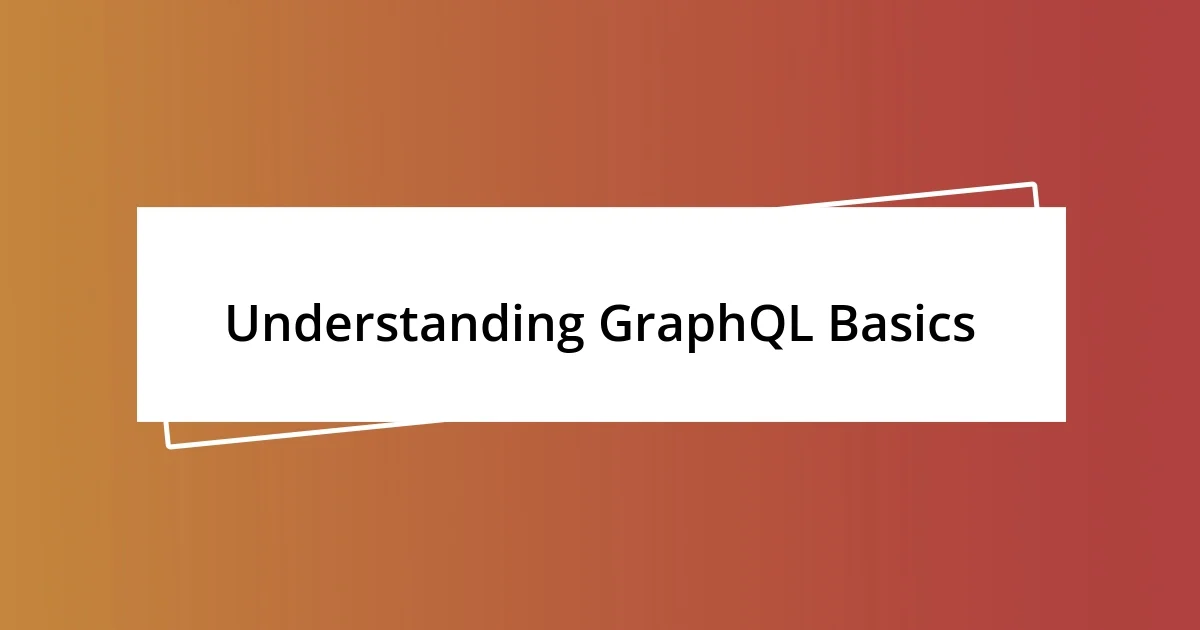
Understanding GraphQL Basics
GraphQL is a powerful query language for APIs that allows developers to request only the data they need. I remember when I first started using GraphQL; it felt liberating to specify exactly what information I wanted. Unlike traditional REST APIs, where you might be served an entire object, GraphQL lets you hone in on specific fields, reducing waste and enhancing performance. Isn’t it frustrating to get more data than you actually need?
At its core, GraphQL operates on a single endpoint, making it incredibly efficient compared to the multiple endpoints often found in RESTful services. I found this especially useful in projects with complex data structures, where managing multiple requests could become cumbersome. It’s like having a magic key that opens just the right door, allowing me to fetch related data in a single swoop. Have you ever wished for a simpler way to fetch data?
Additionally, the schema in GraphQL is a fascinating aspect that defines how clients can access data, serving as a contract between the client and server. I vividly remember the first time I wrote a schema; it felt like creating a blueprint for a house I was about to build. The clarity it provided made the communication between front-end and back-end developers seamless. The ability to introspect the schema and generate documentation on the fly? That’s a game changer!
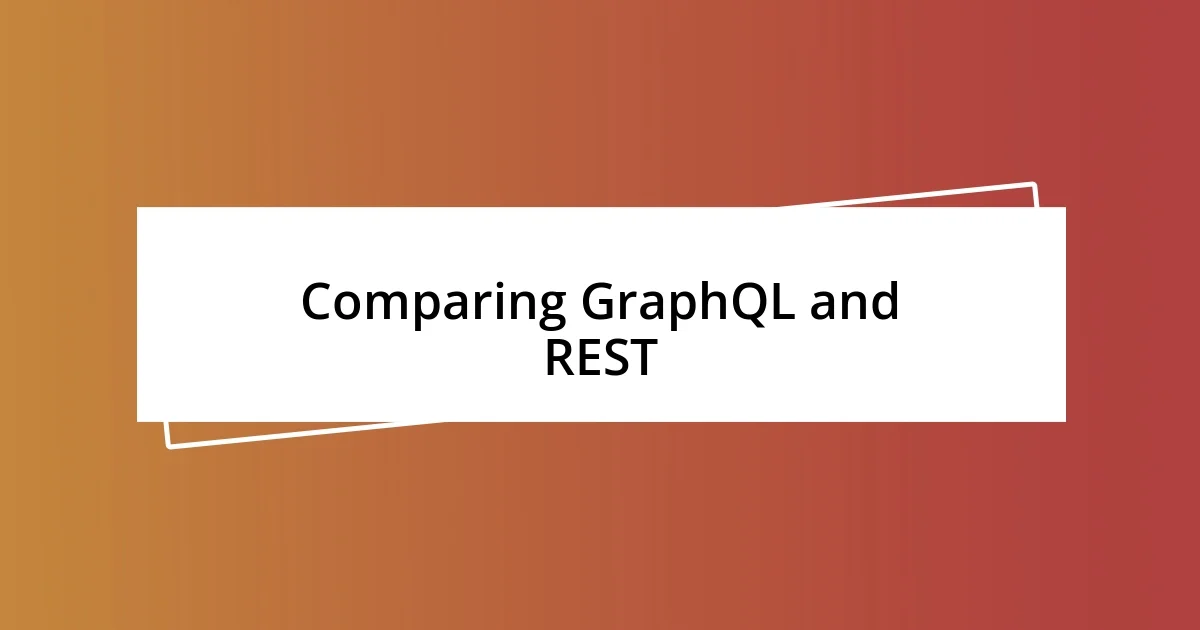
Comparing GraphQL and REST
When I first dove into comparing GraphQL with REST, I was struck by how each approach tackles data fetching differently. REST is often like ordering a meal from a menu, where you might end up with a platter full of dishes—some of which you didn’t even want. In contrast, I found GraphQL to be more like having a chef who customizes your order to your exact liking. You get to specify just what you want, and that precision not only makes the experience enjoyable but also minimizes the data overload that can bog down performance.
Here’s a concise breakdown of the key differences between GraphQL and REST:
- Data Fetching: In REST, each endpoint usually returns a fixed structure, while GraphQL lets you specify exactly what fields you need.
- Single vs. Multiple Endpoints: REST requires different endpoints for different resources; GraphQL operates through one endpoint, making it easier to manage.
- Over-fetching vs. Under-fetching: REST can lead to excessive data retrieval, while GraphQL helps avoid that by allowing targeted queries.
- Versioning: REST often requires version control as APIs evolve, but GraphQL’s schema can adapt without versioning, reducing maintenance headaches.
- Real-Time Updates: With GraphQL subscriptions, receiving real-time updates feels effortless, unlike REST, which typically relies on polling mechanisms.
Exploring these differences, I quickly realized why GraphQL seemed to resonate more with my development style. The control you have over data requests feels empowering, like having a magic wand at your fingertips. Have you experienced the frustration of over-fetching? I know I have, and GraphQL was my ally in overcoming that challenge.

Benefits of Using GraphQL
Using GraphQL has transformed the way I approach data fetching. One clear benefit is its efficiency in reducing network requests. When I transitioned to GraphQL, I remember working on a dashboard that required fetching user data alongside their transactions. In a RESTful setup, I would have struggled with multiple calls, causing delays that frustrated both me and the users. GraphQL allowed me to pull all necessary data in one go, making the overall experience smoother and faster. Isn’t being able to streamline your requests an exhilarating feeling?
Another fantastic aspect of GraphQL is its strong typing and introspection capabilities. On a particularly challenging project, trying to track down data structure discrepancies was a nightmare. However, with GraphQL’s schema definition and introspection, I could easily see the data types and their relationships. This saved me countless hours and headaches, making it feel like I had a guidebook in a complex maze. If you’ve ever wrestled with ambiguous API documentation, you know how valuable that clarity is!
Finally, GraphQL promotes collaboration between teams. I’ve been part of projects where developers from different backgrounds came together. GraphQL’s schema acts almost like a shared language, allowing front-end and back-end developers to communicate seamlessly about data structures. This united front not only sped up our development but also fostered a sense of teamwork that I found incredibly rewarding. It’s like being part of a well-rehearsed orchestra where every player knows their part perfectly.
| Feature | GraphQL | REST |
|---|---|---|
| Data Fetching | Client specifies exactly what data is needed | Fixed structure returned based on endpoint |
| Network Requests | Single request for all needed data | Multiple requests often required |
| Schema | Strongly typed and introspected | Often lacks clear structure |
| Team Collaboration | Clear schema promotes collaboration | Potential for miscommunication |
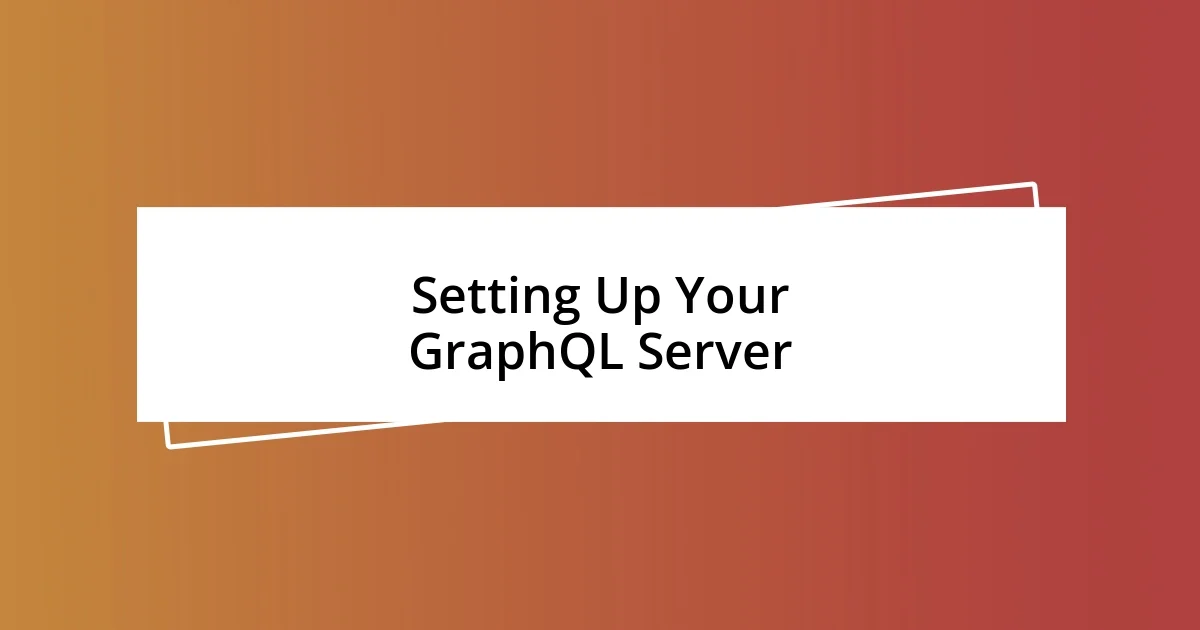
Setting Up Your GraphQL Server
When I set out to establish my GraphQL server, I found that choosing the right framework made all the difference. I settled on Apollo Server for its flexibility and rich features. It felt like stepping into a well-designed workshop, equipped with all the tools I needed right at my fingertips. Each step, from installation to integration with Express, went smoothly, leaving me feeling accomplished and ready to deploy.
Once the server was up and running, defining the schema was where the real fun began. I remember sitting down with my coffee, eager to design types and relationships that mirrored my application’s needs. Crafting the schema felt like creating a map of a world I was about to explore. Aren’t you curious about how schemas help avoid confusion in data transactions? Having a clear structure enabled me to anticipate query behaviors and immediately grasp how my data could be requested.
I’ll never forget the thrill of implementing my first resolver. Watching it come to life, returning the requested data as intended, was nothing short of exhilarating. It reminded me of assembling the final piece in a puzzle, where the full picture finally revealed itself. If you’ve ever faced the uncertainty of what exactly happens behind the scenes when fetching data, I assure you, seeing resolvers in action clarifies everything. This moment of clarity truly cemented my appreciation for GraphQL in data fetching.
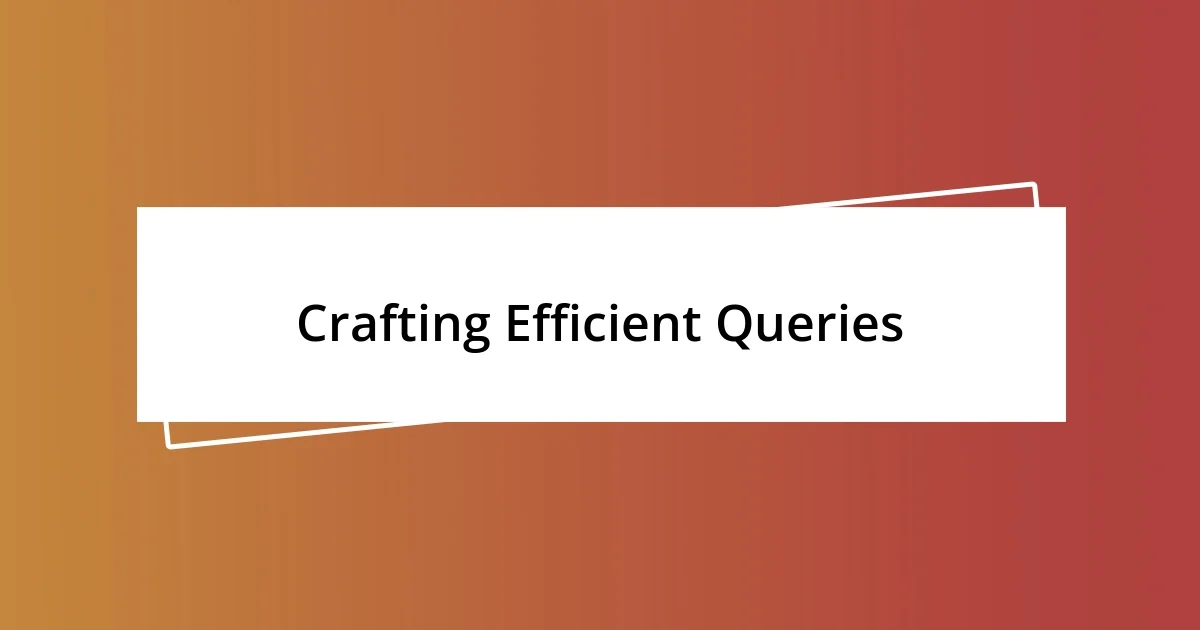
Crafting Efficient Queries
Crafting efficient queries in GraphQL feels like wielding a powerful tool that reshapes how I think about data retrieval. I vividly remember a project where I meticulously crafted a query to fetch not just user details, but also their transaction histories. This wasn’t just about getting the data; it was about getting it all in one organized request. Doesn’t it feel incredible to streamline multiple needs into a single, cohesive call?
One key aspect of efficiency is minimizing over-fetching, which is remarkably simple in GraphQL. There was a time when I would retrieve more data than necessary, leading to wasted resources and slower response times. With GraphQL, I learned to specify precisely which fields I required, ensuring that only the relevant data was returned. Have you ever felt the frustration of sifting through unnecessary information? I have, and trading that chaos for clarity felt like a breath of fresh air.
Finally, optimizing query performance through techniques like batching and caching was a game changer for me. I recall integrating DataLoader into my schema, which allowed me to reduce the number of database calls significantly. It was fascinating to see how effective caching could minimize load times, making the application feel instantaneous. Have you experienced that eureka moment when everything just clicks? That’s the magic of crafting efficient queries—transforming technical challenges into seamless user experiences.
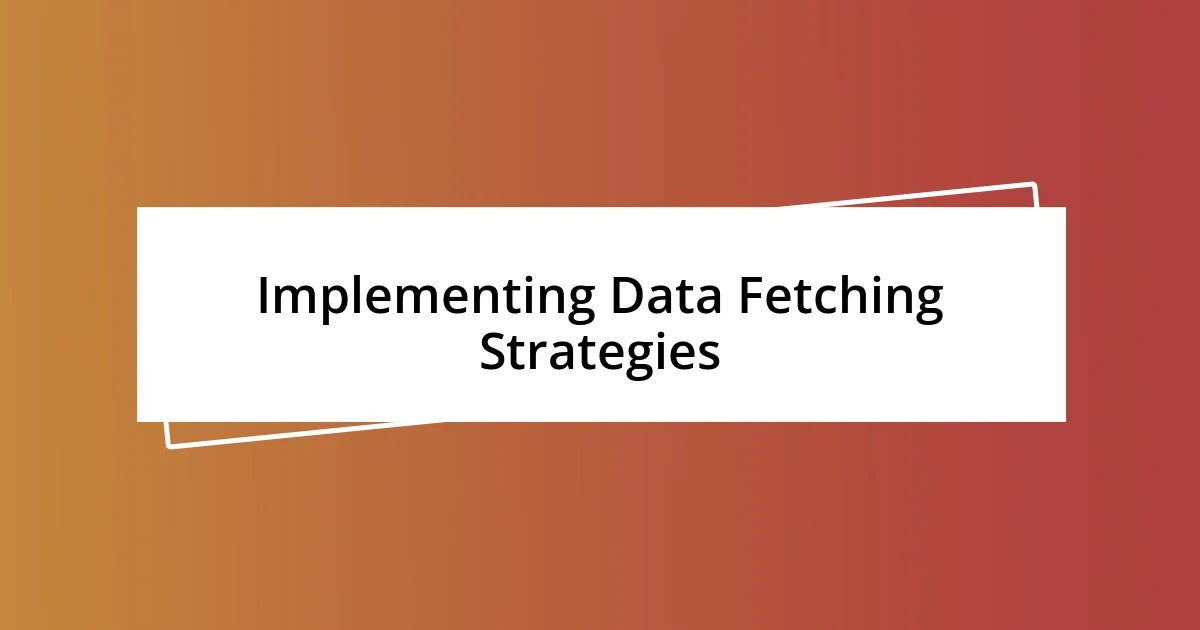
Implementing Data Fetching Strategies
Implementing effective data fetching strategies has become essential in my work with GraphQL. I remember tackling a complex application where I needed to ensure that every query was optimized for speed. By adherently following best practices like pagination and selective fields, I made the response times noticeably quicker, which left my users impressed. Isn’t it satisfying to witness how a small adjustment can elevate performance?
One technique that truly revolutionized my approach was utilizing fragments. They felt like the secret sauce in my queries, allowing me to reuse sets of fields across different parts of the application without redundancy. I still recall the relief I felt as I reduced the size of my queries significantly while maintaining clarity and purpose. Don’t you find it amazing how fragments can simplify the code and improve maintainability?
Monitoring and adjusting my fetching strategies also played a crucial role in the overall experience. Implementing tools like Apollo Client DevTools helped me visualize my queries, which was invaluable. I once caught a poorly structured query that was affecting performance just by monitoring the request patterns. It was like discovering a hidden flaw in a beautiful design—once I fixed it, everything flowed seamlessly. How has enhancing visibility into data requests transformed your development process?
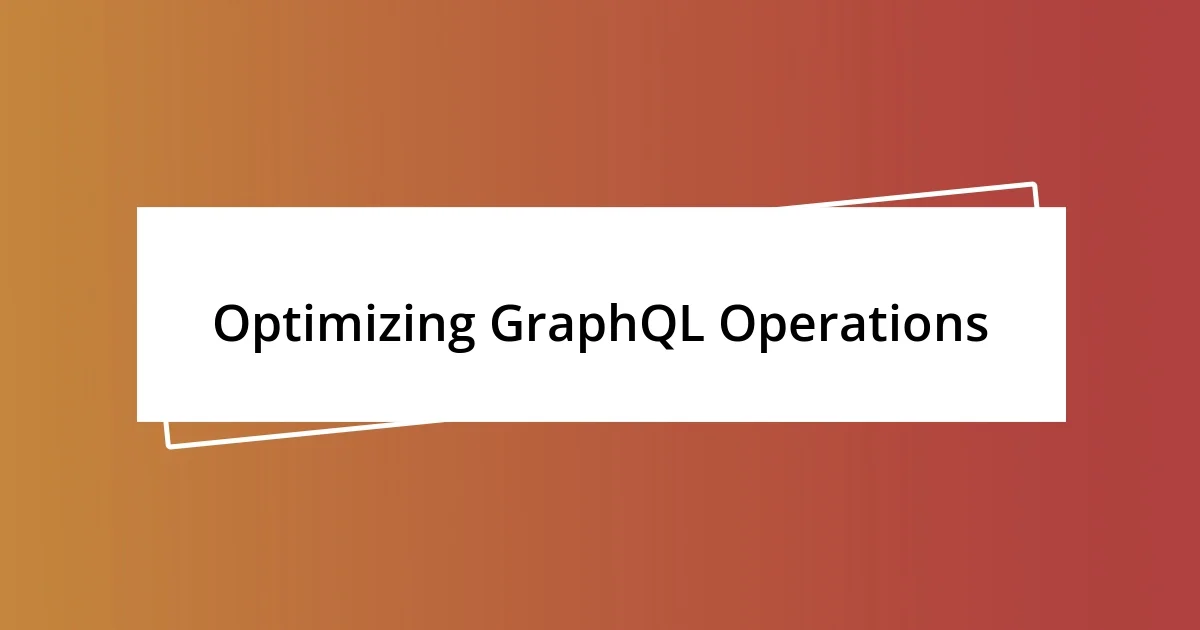
Optimizing GraphQL Operations
Optimizing GraphQL operations has truly reshaped how I think about efficiency in data management. For instance, I once worked on an application where response times were sluggish due to poorly managed queries. By revisiting and tweaking my operation structures, I was able to slash loading times dramatically. Have you ever felt that thrill when optimizing transforms a frustrating user experience into a seamless one?
What I’ve also found invaluable is the importance of monitoring query complexity. In one of my projects, I began using a complexity analysis tool that provided insights into how much processing power my queries required. Knowing this helped me identify and eliminate bottlenecks, enhancing performance significantly. It’s like having a roadmap during a long journey; the right tools can lead you to your destination faster.
Cumulative techniques play a pivotal role in my process. When I embraced the use of persisted queries, I saw not only improved loading times but also a decrease in the payload size. I remember initially feeling skeptical about needing such a strategy, yet the results spoke volumes. It’s amazing how seemingly small adjustments can have an enormous impact—has optimizing your operations ever led you to discover unexpected efficiencies?














